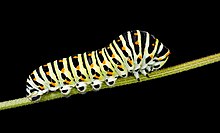
Back يسروع Arabic Laqatu Aymara Tırtıl Azerbaijani Uled BAN Вусень Byelorussian Вусень BE-X-OLD Гъсеница Bulgarian Hulat BJN শুঁয়োপোকা Bengali/Bangla Eruga Catalan



Caterpillars (/ˈkætərpɪlər/ KAT-ər-pil-ər) are the larval stage of members of the order Lepidoptera (the insect order comprising butterflies and moths).
As with most common names, the application of the word is arbitrary, since the larvae of sawflies (suborder Symphyta) are commonly called caterpillars as well.[1][2] Both lepidopteran and symphytan larvae have eruciform body shapes.
Caterpillars of most species eat plant material (often leaves), but not all; some (about 1%) eat insects, and some are even cannibalistic. Some feed on other animal products. For example, clothes moths feed on wool, and horn moths feed on the hooves and horns of dead ungulates.
Caterpillars are typically voracious feeders and many of them are among the most serious of agricultural pests. In fact, many moth species are best known in their caterpillar stages because of the damage they cause to fruits and other agricultural produce, whereas the moths are obscure and do no direct harm. Conversely, various species of caterpillar are valued as sources of silk, as human or animal food, or for biological control of pest plants.
- ^ Eleanor Anne Ormerod (1892). A Text-Book of Agricultural Entomology: Being a Guide to Methods of Insect Life and Means of Prevention of Insect Ravage for the Use of Agriculturists and Agricultural Students. Simpkin, Marshall, Hamilton, Kent & Co. Archived from the original on 2020-09-30. Retrieved 2016-01-27.
- ^ Roger Fabian Anderson (January 1960). Forest and Shade Tree Entomology. Wiley. ISBN 978-0-471-02739-3.
© MMXXIII Rich X Search. We shall prevail. All rights reserved. Rich X Search